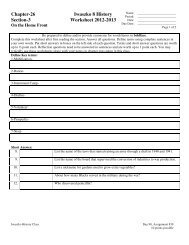âA Brief History of Romeâ - InforMNs
âA Brief History of Romeâ - InforMNs
âA Brief History of Romeâ - InforMNs
You also want an ePaper? Increase the reach of your titles
YUMPU automatically turns print PDFs into web optimized ePapers that Google loves.
Augustus, which means, "respected one." Many Romans deified Augustus after his death. This means they<br />
worshipped him as a god.<br />
Augustus ruled Rome for 41 years, though he did not call himself an emperor. He was careful to not meet the same<br />
fate as his great granduncle. Augustus was very respectful to the senators, but the Senate knew he controlled the army<br />
and could do as he pleased.<br />
The Roman army was so strong that it protected citizens from attacks from the tribes who lived beyond the empire.<br />
The powerful, pr<strong>of</strong>essionally trained forces were divided into large units called legions. Each legion would have as<br />
many as 6,000 soldiers. The two hundred year period that began with the rule <strong>of</strong> Caesar Augustus was known as the<br />
Pax Romana, or the "Peace <strong>of</strong> Rome."<br />
Later Emperors<br />
Augustus had complete power in Rome, but he showed great respect for the senate. Later emperors made no secret<br />
<strong>of</strong> their power. The Senate still existed, but senators had little control over the affairs <strong>of</strong> the empire. Some <strong>of</strong> the<br />
emperors who followed Augustus ruled wisely. Others were foolish and cruel.<br />
Nero was perhaps the most notorious emperor in Roman history. Nero became emperor when his mother conspired<br />
to kill his stepfather. Once Nero came to power, he ordered his mother's execution. He also killed two wives and a<br />
stepbrother. Nero ruled the empire by day, but at night he prowled the streets <strong>of</strong> Rome assaulting women.<br />
He believed himself to be the greatest artist in the empire. Never before had a Roman Emperor appeared on a<br />
stage. Many Roman nobles considered his performances outrageous, but no one would risk torture or death by<br />
criticizing him. In 67 AD, Nero toured Greece. He participated in many games and contests, always finishing first. As<br />
Nero devoted himself to his artistic pursuits, he lost power. In 68 AD, Nero faced a revolt from his soldiers. His guard<br />
claimed Nero lamented, "What an artist the world is losing," then stabbed himself in the neck.<br />
The Roman Empire reached its greatest size in 117 AD under the emperor Trajan. The empire extended from<br />
Britain and Spain, across France, southern Germany, and the Balkan Mountains. The empire also included North<br />
Africa, and stretched as far east as the Caspian Sea. The Romans claimed all <strong>of</strong> the land surrounding the enormous<br />
Mediterranean Sea, which they called "a Roman lake."<br />
In 121 AD, the emperor Hadrian built a wall across northern England to keep out invaders from Scotland. The<br />
Romans called the Scots "barbarians," possibly because their Celtic language reminded the Romans <strong>of</strong> the sounds<br />
made by sheep. In time, the Romans called all <strong>of</strong> the people they felt were uncultured "barbarians." Barbarian warriors<br />
from Germany would later lead to the end <strong>of</strong> the Western Roman Empire.<br />
Roman Technology<br />
The Romans used great public projects to make the city the most advanced <strong>of</strong> the ancient world, and to create the<br />
largest empire <strong>of</strong> the era. Many <strong>of</strong> the roads, bridges and aqueducts <strong>of</strong> ancient Rome are still used today.<br />
The Romans built many roads throughout their empire. The roads made it easier to travel and trade with faraway<br />
provinces. It also made it easier to collect taxes. Roman roads were straight and followed an exact design. The<br />
expression, "All Roads Lead to Rome" refers to the fact that Rome was the center <strong>of</strong> modern civilization.<br />
Roman engineers brought water into the city by building pipelines called aqueducts. Nine aqueducts provided the<br />
Roman people with 38 million gallons <strong>of</strong> water every day. Parts <strong>of</strong> the Roman aqueduct system still supply water to<br />
fountains in Rome.
















